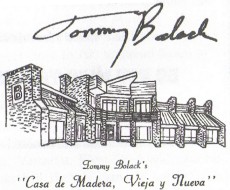Casa de Madera
Reprinted from "Crown Jewels of the Wire", August 1991, page 35
Casa de Madera
Constructed of giant redwoods which towered over the plains of Colorado some
50 million years ago, "Casa de Madera" utilizes these petrified
remains from the Farmington sandstone. Nestled in Madera Cove the structure seems
to have been unearthed from the massive sandstone bluffs near which it rests.
My interest in geology and love for the bluffs spawned the dream over 20 years ago.
The 9.000 square foot structure is unique and took over 3-1/2 years to construct.
The $1.3 million dollar price tag is borne out in the exceptional amount of
naturally finished woods and custom woodwork.
Petrified woods abound, as semi-agatized, agatized and opalized woods are shown.. All. this, with the
exception. of three tons of opalized wood, has come off the 12,500 acre B Square
Ranch. . One natural wood featured is Australian karri from which the beams,
window sills, staircase and kitchen counter top were made. The wood was slated
for use as guide beams in a uranium mine near Grants. Plans were scrapped and
the wood was sold at nearly the price of pine lumber. This wood is extremely
hard and dense and special carbide tipped tools were needed in working it. The
red glow is similar to red mahogany when finished.
Other natural woods include
Arizona Mesquite from which the kitchen cabinets and the den shelves are made.
The beauty of this wood is apparent whether finished or grain laid. Also found
are oak, ash, walnut, bubinga, zebra redwood, ironwood, purpleheart, mahogany,
sassafras, cherry, tammerisk, red and yellow cedar and cottonwood, but very
little pine and fir.
The home's approach is branded with a B of obsidian and marble with a weathering green copper roof as a backdrop. Nearly 700 cubic yards
of concrete and mortar rest in the two story structure. The rocks in the home
have not yet been counted but may approach a million.
To take advantage of the
natural beauty that surrounds it, the home has an abundance of windows. These
are of the double-pane, insulating type with low distortion. The curtains are of
insulating type and are electrically raised and lowered as temperatures require.
The limited winter sunshine made good insulation imperative. All ceilings are
insulated with twelve inches of fiberglass and all walls contain a minimum of
two inches of thermax. Three gas-fired furnaces keep the home quite comfortable. A summer natural convection system keeps the home cool without the
need for auxiliary air conditioning. The plumbing is done with copper piping and
all electrical is placed in metal raceways or conduit. A conduit system and
control area allows stereo. telephone, intercom and cable TV to be wired into
any room and controlled from a single panel. The entire 1/4 mile cove face behind
the house is lighted by ten 1500 watt incandescent mercury flood lights which in
conjunction with support lighting, add up to over 20 kilowatts of outdoor
lighting. As engineer/owner, I personally designed and installed the plumbing
and electrical, as they were a bit more than found in most homes.
One of the highlights of the home is the massive karri spiral staircase
opening to the second story 8' x 11' prism skylight. From the air the Phoenix
shaped structure's head is actually the pointer of a massive sundial. Casting a
shadow upon the dinosaur-tracked and fossil-imprinted patio, mountain standard
time may be found on the sundial. The fossils are modem day leaves "troweled
into" the wet mortar and later removed, and the dinosaur tracks are actual
casts of Dialophosouras tracks from Tuba City, Arizona.
The stereo control
center is veneered in secondary deposited petrified wood and fossils. These have
been rounded by nature in their journey by water and along with live trees, were
deposited in the Farmington sandstone.
The upstairs fireplace contains an array
of unusual agatized petrified woods which were gathered abroad and cut on site.
The study and library is indirectly lit from the north and south and features
the original first National Bank lock boxes. A 200 year old bronze French signal cannon stands guard over 700 year old Anasazi pottery found on the ranch. A
two floor elevator provides easy access.
Navajo rugs and rock contrast with
electric meters, slot machines, juke boxes and pinball games in the recreation
room. Here also is housed the pride of my collections in lighted display cases --
"The Insulators." Dated from the 1840s, the collection "runs the
rainbow" and is one of the largest in the country. It represents over 25
years of collecting.
From the petrified wood "pickets" to the massive
rocks and boulders, the surrounding landscape tends to blend in with the home
and its backdrop.
Enjoy your drive along the lake, river and radial wave lights
and watch for wildlife along the way.
As friends and neighbors I hope you enjoy
your visit to my home as much as I am enjoying having you here. The project took
a long time, and at times I wondered if I would ever finish, but positive
results are always worth waiting for! Feel free to look around, get ideas and
ask questions. Thanks so much for sharing your time.

- - - - - - - - - - - - -
CASA DE MADERA has got to be one of the most incredible places we have ever
visited in our travels throughout the United States. The Bolack Square B ranch
is a tribute to engineering genius and environmental preservation -- a rare treat
will be afforded those who attend the Enchantment Insulator Club Show September
28th, Will we see you there? Hope so. I'll be there!
...................Your Editor
| 